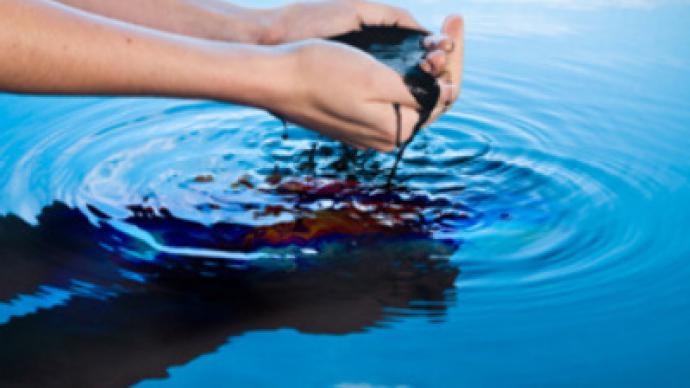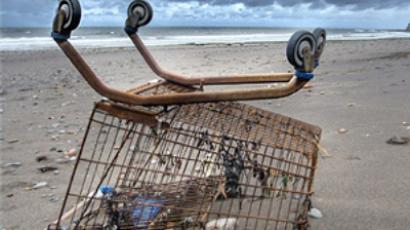Water is the new oil

Russia is considering becoming the world’s top supplier of fresh water as growing demand turns it into a strategic resource. That is if it can upgrade its own consumption to modern standards.
If you pay attention to the perils that future may bring, you probably know that the oil will run dry, the sea level will rise and drown coastal regions, and that fresh water will be such a valuable asset that even the oil price will seem low in comparison. All this provided that the world will not end in 2012 in accordance with Mayan prophecies, of course.
The future global water crisis is indeed a gloomy thing: by 2030 half of world’s population will face a fresh water deficit, according to the UN's World Water Assessment Program forecast. Thirsty nations will take up arms against their saturated neighbors. People drinking polluted water will become ill. Ecologies will die out when the rivers feeding them are depleted for the sake of human farms and factories.
Russia has world’s second-largest water reserves after Brazil (it’s hard to compete with the Amazon River, but having in your territory the world’s largest lake, Baikal, which contains 20 per cent of the world’s fresh surface water, really helps).
Could it be that in 20 years the country, in addition to being a reliable supplier of hydrocarbons (or holding EU in energy grip, if you prefer this point of view), will also be a top supplier of stuff to drink?
The problem does exist, but…
Global demand for fresh water is growing steadily. Not only is humanity itself becoming more numerous, it also consumes more water per capita than it used to. The latter happens indirectly as developing countries become hungrier for things requiring much water to produce – paper, synthetic fibers, even home appliances and cars, but first of all foods.
Agriculture is the single biggest consumer of water, accounting for some 70 per cent of the total volume we expend. And among different food products demand different volumes of water to produce. One kilo of beef “drinks” an estimated 15,000 liters, compared to 1,000 liters needed for one kilo of wheat. The new armies of cows and pigs grown to replace rice on the plates of Chinese workers make this hidden strain on rivers and groundwater.
Conflicts over water are evident, especially in regions where the resource is scarce. Water consumption is one of the stumbling blocks in the conflict between Israel and Palestine, as well as a constant source of tension between the Jewish state, Lebanon and Jordan. Turkey is in a quarrel with Syria and Iraq over the use of water from the Euphrates and Tigris Rivers. Other hotspots include Central Asia and Northern Africa.
Health problems which poor water quality can cause are also hard to deny, with an estimated 80 per cent of diseases in the world linked to it in some way. For instance, world’s largest mass arsenic poisoning – which is believed to have affected up to 77 million people in Bangladesh over 40 years and account for some 20 per cent of deaths in the country – was caused by contaminated water. Ironically, the source is the numerous wells drilled with help from international organizations to provide water cleanse it of pathogens.
However, a 2006 UN report on global water deficit points out that much of the problems stir not from the physical absence of freshwater, but rather from poor governance and lack of investment into things like sewage treatment and efficient use of water. Despite arid climate, wealthy Persian Gulf countries can afford desalination and extraction of fossil water, which, combined with good consumption practices, allows providing its population. Of course, it is of little consolation for the poor folk, but leaves room for optimism nevertheless.
Water superpower – not just yet
The goal of the future is to deliver the existing water from places of abundance to those in need. But if you are picturing great pipelines running from Siberian rivers to Spain and tanker fleets carrying Baikal water to the sheikhs, you are a little bit unrealistic. It is not economically viable.
Water is much cheaper than oil or gas, which means the cost of its transportation puts a greater barrier on trade, and annual volumes consumed are much greater. For instance, Russia’s domestic water consumption is 180 times higher than that of domestic oil consumption.
The solution could be great channels, which would bring water to buyers in a natural flow, but those require extremely high capital investment. Even China, famous for cyclopean infrastructure projects, is hesitant to pay for its South–North Water Transfer Project, the system of channels which would supply the water-hungry north of the country with water from the south. Putting such investment for the sake of foreign buyers rather then your own economy would be optimistic and short-sighted at best.
Also, unlike with energy, alternative sources of fresh water are there to be used. Sea water desalination has being improving over the decades, and the most cost-efficient facilities produce water at around $0.5 per cubic meter today. There is also iceberg towage, which is done on a limited scale in Canada now, but has the potential to become a regular enterprise in a thirstier world. Optimistic estimates promise iceberg water at $0.8 per cubic meter.
A more realistic approach would be the development of domestic industries, which require much water, like agriculture or production of nuclear power, and exporting the products instead.
Finally Russia, with all its water riches, has problems providing its own population, and the fact that most of the people live in the European part of the country while water is more abundant in the east is just a small part of the problem. According to government estimates voiced at the international forum Pure Water 2010 in Moscow, less then 40 per cent of Russians drink safe water. Some 25 per cent of the people have no centralized water supply at all.
Water usage in Russia suffers from poor efficiency, which is two to three times below that in Europe. To change the situation, large-scale investment into water saving technology and public campaigning are needed. A government-sponsored modernization program currently on the table is expected to be launched next year. Prime Minister Putin said its budget will be $300 million over the first three years. The sum “is not grand, yet noticeable” he admitted.
Alexandre Antonov, RT













